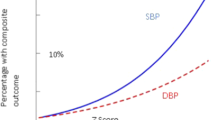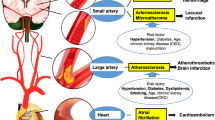Abstract
The basic underlying pathophysiological processes underlying the major complications of hypertension (that is, heart attacks and strokes) are thrombogenesis and atherogenesis. Indeed, despite the blood vessels being exposed to high pressures in hypertension, the complications of hypertension are paradoxically thrombotic in nature rather than haemorrhagic. The evidence suggests that hypertension appears to confer a prothrombotic or hypercoagulable state, which can be related to conventional risk factors, target organ damage, complications and long-term prognosis, as well as different antihypertensive treatments. Further work is needed to examine the mechanisms leading to this phenomenon, the potential prognostic and treatment implications, and the possible value of measuring these parameters in routine clinical practice.
This is a preview of subscription content, access via your institution
Access options
Subscribe to this journal
Receive 12 digital issues and online access to articles
$119.00 per year
only $9.92 per issue
Buy this article
- Purchase on Springer Link
- Instant access to full article PDF
Prices may be subject to local taxes which are calculated during checkout
Similar content being viewed by others
Author information
Authors and Affiliations
Corresponding author
Rights and permissions
About this article
Cite this article
Lip, G. Hypertension and the prothrombotic state. J Hum Hypertens 14, 687–690 (2000). https://doi.org/10.1038/sj.jhh.1001051
Received:
Accepted:
Published:
Issue Date:
DOI: https://doi.org/10.1038/sj.jhh.1001051
Keywords
This article is cited by
-
Targeting hypercoagulation to alleviate Alzheimer’s disease progression in metabolic syndrome
International Journal of Obesity (2022)
-
The heart in hypertension
Journal of Human Hypertension (2021)
-
Implications of AB0 blood group in hypertensive patients with covid-19
BMC Cardiovascular Disorders (2020)
-
Circulating levels of cell adhesion molecules in hypertension
Indian Journal of Clinical Biochemistry (2009)
-
The interaction of vasoactive substances during exercise modulates platelet aggregation in hypertension and coronary artery disease
BMC Cardiovascular Disorders (2008)



